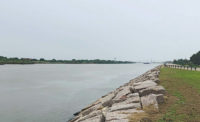The manufacturer of the world's largest artificial swimming pools, Santiago, Chile-based Crystal Lagoons, has announced plans to build its massive recreational lagoons in the United States.
In a deal announced on June 25, Tampa, Fla.-based Metro Development Group will oversee construction of four artificial lagoons in Florida using Crystal Lagoons' technology. "In terms of final size, we're trying to make them each a minimum of 5.5 acres, maybe over eight acres in size on some sites," says Greg Singleton, Metro Development Group president.
While an eight-acre artificial lagoon may seem impressive, it's a kiddie pool compared to some of Crystal Lagoon's world-record-sized projects. At the Sharm El Sheikh resort in Egypt, Crystal Lagoons has built a 29.2-acre pool, the largest in the world. It is expected to hold that record until 2017, when a 86.4-acre Crystal Lagoon is set to be completed at Mohammed Bin Rashid City in Dubai. [View a slideshow of some of Crystal Lagoons' largest pool projects.]
Invented and developed by Chilean biochemist Fernando Fischmann, Crystal Lagoons' technology was first tried in Chile in 1996 but was not perfected until 2006. The first site, the San Alfonso del Mar resort in Valparaíso, Chile, is about 70 miles west of Santiago. The Pacific Ocean's Humboldt current makes most of Chile's coastal waters too cold for swimming, limiting the attractions at a seaside resort. The San Alfonso del Mar lagoon takes in, filters and warms seawater enough for water recreation. "We have 58 projects in Chile alone," says Kevin Morgan, CEO, Crystal Lagoons U.S. Corp. "But we're now estimating 14,000 projects globally over the next 15 years, with 2,000 projects in the U.S. alone."
On closer inspection, the world's largest pools don't really resemble traditional swimming pools. These artificial bodies of water are not treated or filtered with the same regularity as the average U.S. swimming pool and use a targeted filtration system to reduce operating costs.
Rather than follow traditional swimming-pool design and construction, with a basin made of concrete or shotcrete, Crystal Lagoons uses a polyurethane liner that is laid out on compacted sand or clay. "The unrolled liner is put on compacted earth, without any other foundation. There's concrete only at approaches and side walls," says Morgan.
This simplified construction leads to cost savings, says Morgan. "For a five- to 10-acre pool, it's $200,000 to $300,000 to build it. Then about $2,500 to $3,000 a month per acre to run it," he says.
In some cases, the lagoon can be used for pretreatment in water purification systems, such as with the MBRC development in Dubai, which will use brackish well water. Crystal Lagoons also is involved in a pilot project with Chilean utility Endesa to use an artificial lagoon as part of a heat exchange for a powerplant.
In order to keep the lagoons in a usable state without regularly filtering and chemically treating all the water, Crystal Lagoons remotely monitors all its lagoons and uses a combination of ultrasound and "pulse" cleaning. "Our disinfection system uses less chlorine than a pool filter," explains Morgan. "We emit ultrasound frequencies into the water, and that pushes microorganisms and debris together. They sink to the bottom, and we retrieve it. Then, there's, like, a little Zamboni that goes through and collects the debris. We're filtering effectively only 1% of the lagoon."
The difference between Crystal Lagoons' low-filtration, low-chemical "pulse" system and the more stringent requirements for swimming pools in most U.S. states has slowed the company's expansion into this country. But after considering myriad state regulations, Kevin Morgan thinks the company has found their way into the U.S. market.











